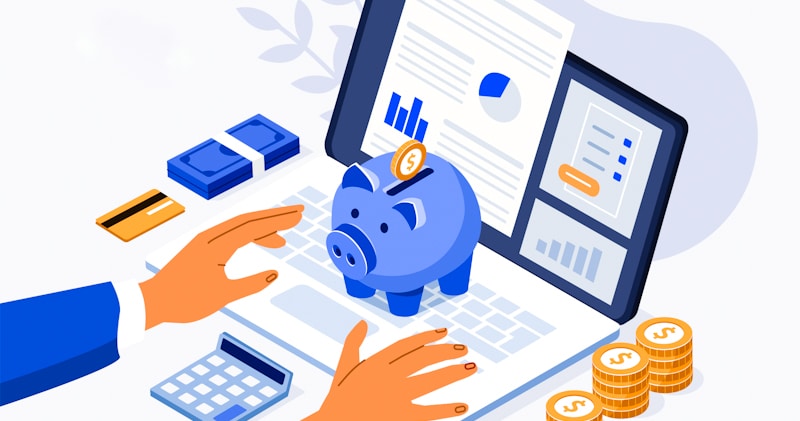

Let’s face it: adulting sucks—especially if you have to make your paycheck perform miracles each month.
Fortunately, a little trick called budgeting can help you win the battle of your bills.
However, if you’re like most Americans, financial planning wasn’t part of your curriculum. In fact, until recently, only 17 states required students to take a personal finance class in high school, so no one can blame you if your idea of budgeting is borrowing cash to cover shortfalls before your next paycheck.
In this post, we’ll rectify this travesty by teaching you how to make a budget properly.

You can only know how much you have to spend if you know how much you have coming into your household coffers. Therefore, budgeting should always start with calculating your income after taxes and other deductions. This is often referred to as your take-home pay or net income.
If you have a regular 9-5 job like most people, determining this amount is relatively easy. Simply look at your paycheck or direct deposit total on payday.
The figure you see is your gross pay minus mandatory and voluntary deductions, as well as contributions to employer-provided programs.
These deductions can include but are not limited to:
But what if you’re a small business owner or freelancer?
Figuring out your monthly earnings is slightly more complicated. Not only do you likely earn irregular income, but your taxes aren’t automatically deducted from your paycheck each month.
In this case, the easiest way to budget is based on an average monthly income.
To calculate an average, add up your total gross income for the past 12 months (or less if you haven’t been operating as a sole proprietor for that long) and then deduct allowable business expenses for the same time period to determine your estimated taxable income.
You’ll then want to divide this figure by the number of months you’re working with to get an average income for each month.
For example, if you’ve calculated taxable income for an entire year, divide the figure by 12. However, if you’ve only done it for six months, divide your answer by six.
Since you haven’t accounted for taxes yet, part of your budgeting process will be to include a savings account for income tax payments. This should include monthly estimates for the following:
Although the amount you owe in taxes will change depending on what you earn during the tax year, budgeting 25%-30% of every paycheck for taxes is a good rule of thumb.
Next, you need to know how much you spend every month by creating a complete list of expenses.
For comparison, the average household in America spends around $61,334 per year (roughly $5,111 per month) on living expenses, according to the most recent report from the U.S. Bureau of Labor Statistics.
What exactly do they spend it on?
Three main expense categories make up a typical budget:
Fixed Expenses: These are bills that don’t change—they’re exactly the same amount every month. Typically, they include rent, mortgage, property taxes, HOA dues, all types of insurance, all loan repayments and other fixed debt obligations, daycare, subscriptions, streaming services, membership payments, and phone, cable, and internet bills.
If you pay any of these expenses annually, you can add them to the sinking fund category.
Variable Expenses: These costs change from month to month, sometimes due to usage and sometimes due to fluctuating prices. For example, utility bills for electricity and water will vary based on how much you use, while your grocery bill will increase or decrease based on ever-changing food prices.
However, you still have some form of control by deciding how much you want to spend on these items. You should have a good idea of how much you spend on average for certain things by reviewing totals from previous months.
We’ll detail some of the more irregular variable expenses in step three, but variable costs usually include these types of expenses:
Savings and Sinking Funds: These funds are for things you’re saving for in the future, whether it’s for retirement, emergencies, or large purchases. By deciding how much you want to save for each item and then breaking down those costs into monthly savings amounts, you’ll be better prepared to cover these costs in the future.
Savings and sinking funds can include emergency savings, general savings, retirement, college funds, a home down payment, vacations, home repairs and maintenance, vehicle repairs and maintenance, and any other large purchases you plan to make in the coming months and years.
If you diligently stick to your budget but still run out of money before the month ends, the chances are that irregular expenses are to blame. These are the often-forgotten bills that crop up infrequently and wreak havoc on your budget as you’re usually left scrambling to find extra greenbacks between the couch cushions if you haven’t set an amount aside for them already.
The good news is that many of these expenses are predictable, so you can easily remove the element of surprise. Simply consider all of your expenses over the entire year, make a list of irregular payments, total their cost, and then divide that figure by 12 to create a single monthly bill you can incorporate into your budget.
Examples of irregular expenses include:
You’ve likely pinpointed some of these infrequent costs while completing step two but go through your bank statements and receipts with a fine-tooth comb to ensure you catch everything and avoid nasty surprises. Even though some of these costs might seem far out, planning for them now will ensure you don’t blow your budget later.
Now that you have a better idea of your monthly expenditure, how does it compare to your income?
If you have sufficient funds to cover your bills, pay off debt, and store some in savings for a rainy day, excellent work!
However, if you have more payments than paycheck, you have two options to create some wiggle room: 1) decrease your spending and/or 2) increase your income.
To reduce your bills, start by auditing your expenses.
Work through your list of expenses to see where you can make changes that’ll free up some cash. Often, you’ll find items in the irregular spending or discretionary spending categories that you can give the proverbial boot.
Unfortunately, budgeting—especially when you’re drowning in debt—requires sacrifice.
While you should keep line items that are needs, such as rent, utilities, transportation, food, and clothing, be ruthless about getting rid of nonessential expenses (usually your wants) that aren’t currently serving your financial goals.
Depending on your situation, you may be able to get away with minimizing rather than eliminating certain items. For example, consider eating out once every two weeks rather than twice a week.
Keep in mind that these changes won’t be forever. Once you have savings and a little financial freedom, you can work some of your treats back into your budget.

Another way to ease the burden of a short or tight budget is to earn more. And if you think that’s easier said than done, you haven’t been paying attention over the last decade or so.
Thanks to the internet and other techy inventions like apps, the gig economy is exploding. There’s now more opportunity to make some extra cash than ever before, but gigs aren’t all you can take advantage of to make some more moolah.
Here are some other ideas to put additional cash in the income section of your budget:
Ultimately, you can’t set aside money for future goals or occasional splurges if you’re only living paycheck to paycheck. Increasing your income not only helps you better manage your budget and reach savings goals but also reduces financial anxiety and allows you to live a better quality of life.
A 2020 Intuit survey revealed that a shocking 65% of Americans didn’t know how much they spent the prior month. Perhaps that explains why a Slickdeals survey conducted just a few months earlier found Americans tend to exceed their budget by $7429.24 every year.
Although most people find it a pain in the neck, the reality is that tracking your spending is the only way you’ll know where your money goes each month, which expenses you might have missed, and which nasty money habits you need to break pronto. After all, you shouldn’t be spending more on coffee and takeout than on savings for retirement.
So, what kind of spending patterns can negatively impact your financial health?
You’re about to begin a great habit with budgeting, so don’t fall off the bandwagon here.
Fortunately, monitoring your spending isn’t as time-consuming as it once was. Today, there are hundreds of personal finance apps with built-in budgeting features that automatically track each transaction and categorize it accordingly. Alternatively, you can go old-school with a computer spreadsheet, the envelope system, or a good ol’ pen and paper.
All you’re doing here is identifying where you’re commonly spending money, how much you’re spending, and whether your budget accounts for these expenses. As a result, you can identify where you can cut back and make necessary adjustments that free up more cash flow each month.
This entire process isn’t about restricting yourself but rather improving your money management prowess so that you can experience the freedom only financial success affords.
That said, it doesn’t help if you’re noting every transaction and identifying spending patterns but not doing anything about it. This brings us to the final step in our process.
Budgeting isn’t a one-and-done activity. It’s just the first step in taking control of your finances.
And since your needs and goals will change over time, your budget must adapt too.
How do you review your budget?
The ultimate goal of any budget review is to ensure the budget and subsequent monthly changes are working. If you’re surprised, you’ve failed.
That doesn’t mean your budgeting journey is over, though—far from it. Simply adjust and try again. You may have simply set unrealistic goals or missed miscellaneous expenses. The key to success is to stay committed and keep working at it until you get it right.

Before we wrap this thing up and send you on your merry way to becoming a budgeting brainiac, we leave you with these bonus money management tips to crush your first budget and beyond:
According to a recent personal finance survey by OppLoans, 73% of Americans admitted to not regularly following a budget, while one in ten respondents didn’t follow any budget at all.
Here’s the thing: budgeting provides guardrails. Besides creating designated limits for spending, it helps you achieve your financial goals and gives you peace of mind. A Debt.com survey found that nearly 85% of people who stuck to a budget were able to get out of debt and stay out of it.
As inflation increases, the economy seems to be teaching a masterclass in budgeting all on its own. So, before you learn any more money lessons the hard way, use our seven-step process to learn how to make a budget and start doing it the right way today.

